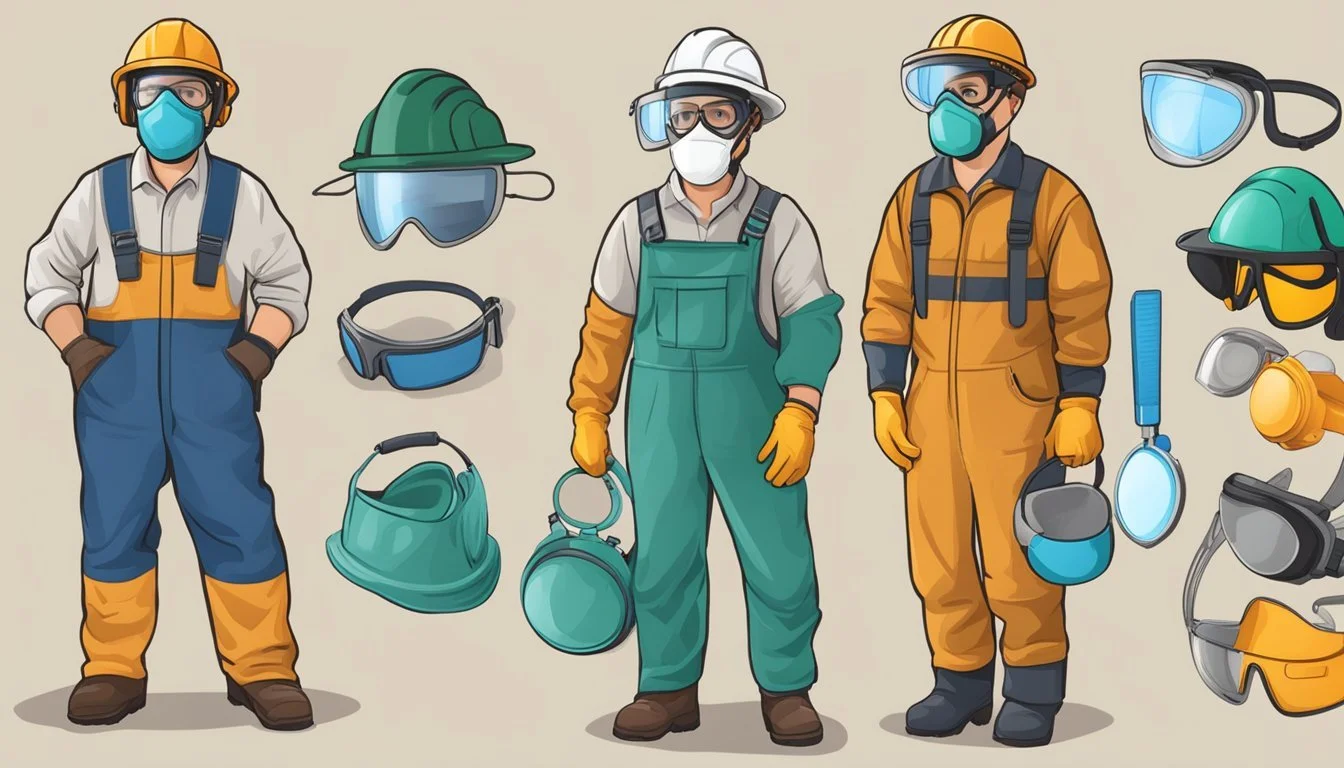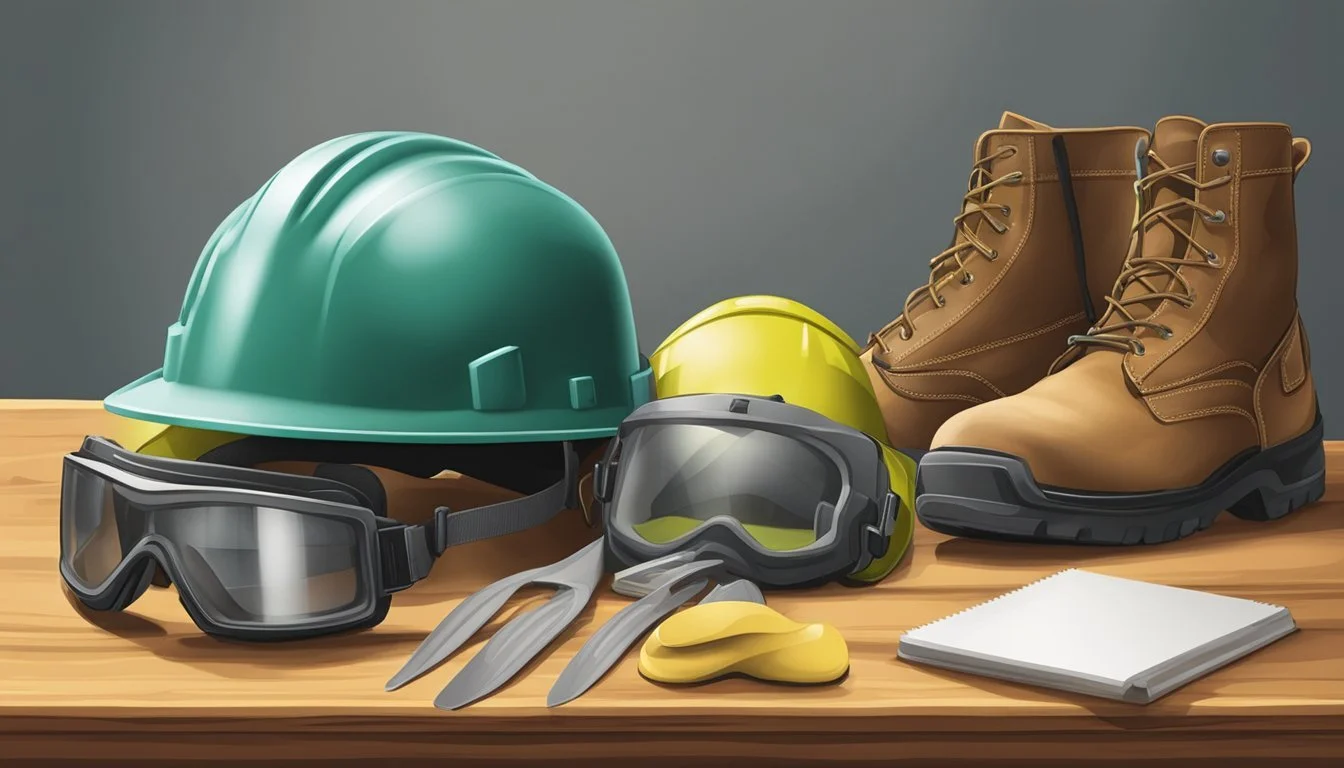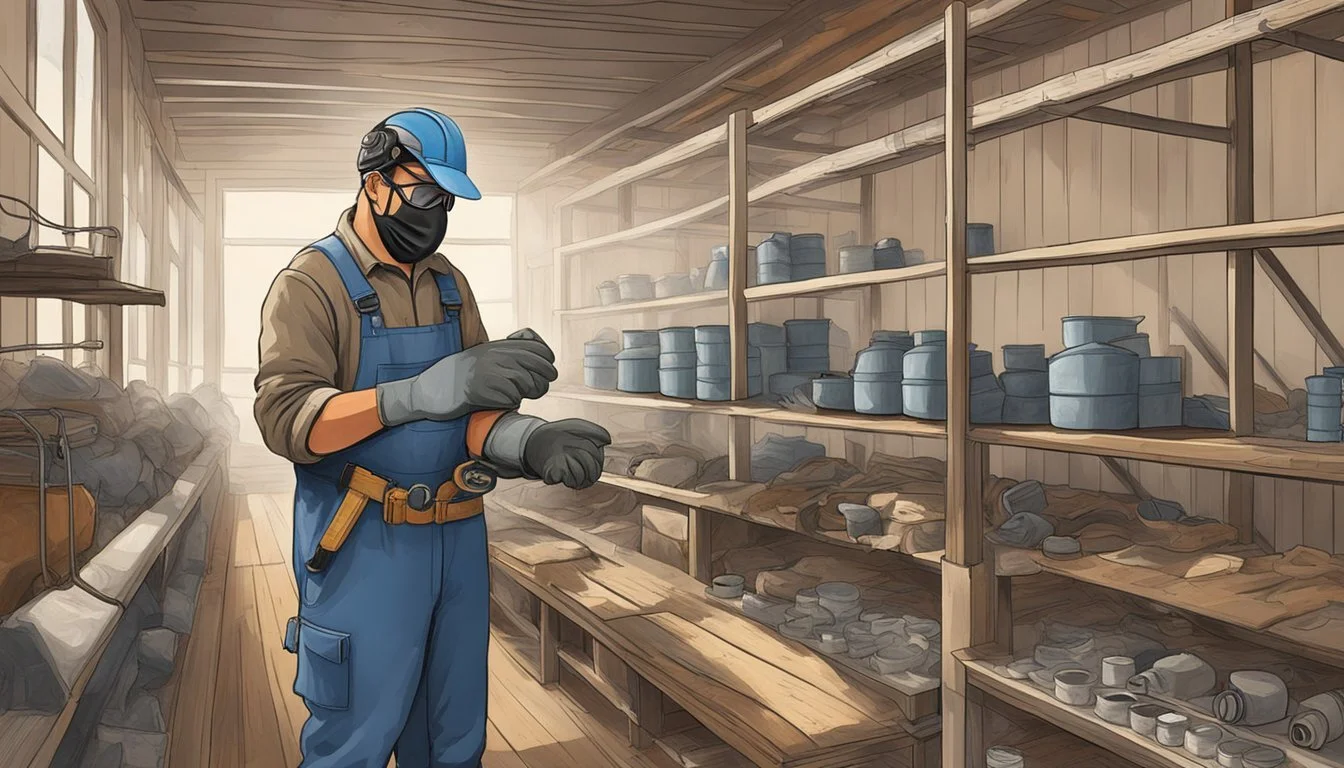The Importance of Safety Gear for Personal Protection in Homesteading Tasks
Ensuring Well-being on the Homestead
Personal protective equipment, commonly abbreviated as PPE, is crucial for individuals engaged in homesteading. Homesteaders often find themselves performing diverse tasks ranging from gardening to animal care, and each of these activities brings its own set of risks. The use of safety gear helps reduce exposure to potential hazards, whether it's from handling tools, dealing with livestock, or managing the land. Safety gear is designed to shield the body from injury and prevent long-term health problems that could arise from repeated exposure to hazards.
In homesteading, the variety of tasks necessitates a range of protective gear. Durable work jeans and gloves protect the skin from scrapes and cuts while working with plants or building materials. Footwear like waterproof boots provide stability and protection in various outdoor conditions. Moreover, specialized equipment like face masks is vital for protection against airborne particles, chemical sprays or dust encountered during farming activities. Homesteaders must be well-acquainted with the specific types of PPE required for each task to ensure a safe working environment.
Proper selection and use of PPE are as important as the equipment itself. It involves understanding the specific hazards of a task and choosing gear that offers adequate protection without hindering the activity. Furthermore, maintaining the condition of safety gear and replacing it when necessary is essential to ensure it continues to provide the intended level of security. Effective PPE use in homesteading is a blend of awareness, education, and diligence, forming the foundation for maintaining personal safety.
Understanding Personal Protective Equipment (PPE)
Personal Protective Equipment, commonly known as PPE, is essential for maintaining safety during various homesteading tasks. It serves as the first line of defense against potential hazards.
Defining PPE and Its Importance
Personal Protective Equipment (PPE) refers to protective clothing, helmets, goggles, or other gear designed to safeguard the wearer's body from injury or infection. The importance of PPE lies in its ability to reduce exposure to hazards when other control measures are not feasible. Proper use of PPE minimizes the risk of accidents and injuries, especially in environments prone to chemical, physical, or biological exposure.
Categories of PPE
PPE can be categorized based on the part of the body they protect. Here are the main categories:
Head Protection: This includes items like hard hats, which shield users from impacts and falling objects.
Eye and Face Protection: Safety features such as safety glasses, goggles, and face shields protect against flying debris, splashes, and intense light.
Hearing Protection: Exposure to high noise levels can be mitigated with the use of earplugs and hearing protection devices like earmuffs.
Respiratory Protection: Equipment such as masks offer defense against inhalation hazards, ensuring clean air intake.
Hand Protection: A variety of gloves provide skin protection against chemicals, cuts, and extreme temperatures.
Foot Protection: Safety shoes or boots with reinforced toes and soles shield feet from crushing blows or punctures.
Body Protection: Protective clothing like aprons, coveralls, and vests provide barrier protection against spills and sharp objects.
Assessment of homestead-related hazards is crucial to determine the appropriate PPE. A thorough hazard assessment identifies potential risks, laying the groundwork for selecting the correct form of protection across these categories.
PPE for Different Types of Hazards
Personal protective equipment (PPE) plays a critical role in safeguarding individuals involved in homesteading tasks from diverse hazards that may cause harm. Selecting the right PPE ensures protection against specific risks associated with chemicals, physical injuries, respiratory dangers, and electrical mishaps.
Chemical Protection
For protection from chemical hazards such as chemical splashes and exposure to toxic chemicals, individuals should use impermeable gloves, safety goggles, and face shields. Chemical-resistant clothing, like aprons or coveralls, is also advisable to prevent skin contact with hazardous substances.
Gloves: Nitrile or PVC gloves for handling chemicals
Goggles: ANSI-approved, tight-fitting safety goggles
Clothing: Long-sleeved shirts and long pants, or chemical-resistant suits
Physical Injury Protection
Homesteading often involves manual labor where risks of cuts, punctures, and abrasions can occur from sharp objects, as well as blows from falling objects. Durable gloves, safety helmets, and steel-toe boots are essential to mitigate the risk of physical injury.
Hand Protection: Heavy-duty gloves for handling tools and materials
Head Protection: ANSI-approved helmets to guard against impacts
Foot Protection: Steel-toe boots to protect feet from crush injuries
Respiratory Hazards
When dealing with dust, fumes, and airborne contaminants, appropriate respiratory gear, like N95 masks or more advanced respirators for heavier exposures, is necessary. This PPE must fit correctly to ensure an effective seal against hazardous particles.
Dust Masks: For less toxic dust, such as sawdust
Respirators: Half-face or full-face respirators for significant exposures to harmful substances
Electrical Hazards
Risk of electrical shock or arc flash while working with electrical installations requires non-conductive PPE. Rubber insulating gloves, dielectric footwear, and arc-rated clothing help in reducing the likelihood of serious electrical injuries.
Hand Protection: Rubber insulating gloves with leather protectors
Foot Protection: Insulating boots to reduce ground electrical potential
Body Protection: Flame-resistant (FR) clothing to protect against potential arc flash
By selecting and using the appropriate personal protective equipment, homesteaders can significantly decrease the risk of exposure to a multitude of hazards, ensuring a safer working environment.
Essential Safety Gear for Specific Tasks
Selecting the correct safety gear is crucial for protecting homesteaders against the inherent dangers of construction and farming, electrical work, and handling chemicals. The right personal protective equipment (PPE) reduces risks and ensures safety during various job tasks.
Protection in Construction and Farming
Construction and farming are labor-intensive tasks that expose workers to extreme temperatures and potential injuries. High-visibility clothing is essential for ensuring that workers are seen in all levels of light, particularly during dawn and dusk. Safety boots, usually made from sturdy leather, are critical for foot protection, designed to prevent slips, trips, and falls, and to protect against sharp objects. Gloves must be selected based on the specific task: heavy-duty leather gloves are suitable for handling equipment, while insulated gloves protect against extreme temperatures. Moreover, knee pads provide cushioning for tasks that require prolonged kneeling.
PPE List for Construction and Farming:
High-visibility clothing for visibility and safety
Leather safety boots for foot protection
Leather gloves for hand protection
Insulated gloves for temperature extremes
Knee pads for knee protection
Protective Gear for Electrical Work
When engaging in electrical work, ensuring one's safety from electric shocks is paramount. Technicians must wear protective gear to prevent electrocution. This includes specially designed insulating gloves and flame-resistant clothing to protect against electrical arcs and burns. To safeguard the feet, dielectric boots made of non-conductive materials are recommended as they provide additional protection against electric shocks.
PPE Essentials for Electrical Work:
Insulating gloves for hand and body protection
Flame-resistant clothing to prevent burn injuries
Dielectric boots to protect against electric shocks
Safety Equipment for Handling Chemicals
Handling agricultural chemicals requires meticulous skin and body protection to prevent contaminants from causing harm. It's essential to wear chemical-resistant gloves and aprons or full-body suits made from materials that can withstand harmful substances. Additionally, using respiratory protection, such as masks or respirators, is necessary when there is a risk of inhaling toxic fumes. Eye protection using goggles or full-face shields is also mandatory to guard against chemical splashes.
Protective Gear for Chemical Handling:
Chemical-resistant gloves, aprons, and body suits for skin protection
Respiratory masks or respirators to avoid inhalation of toxic fumes
Goggles or full-face shields for eye protection
Compliance and Safety Standards
To ensure a safe and compliant homesteading environment, understanding and adhering to regulatory compliance and safety standards is essential. These guidelines are vital to keeping tasks performed on homesteads safe and efficient.
OSHA Regulations and Compliance
The Occupational Safety and Health Administration (OSHA) sets forth rigorous regulations that employers must follow to guarantee a safe workplace. For homesteaders, compliance with OSHA means that any employed laborers are offered protection through necessary training and the right Personal Protective Equipment (PPE). Within homesteading operations, this could include protective gear such as gloves, eye protection, and appropriate footwear when handling machinery or animals.
Key OSHA Compliance Aspects for Homesteading:
Training: Educate employees about potential hazards and proper PPE usage.
Hygiene: Maintain clean work environments to minimize health risks.
ANSI Standards and Certification
Standards developed by the American National Standards Institute (ANSI) play a crucial part in ensuring the quality and performance of PPE. Products bearing ANSI certification have met the benchmarks for safety, and by selecting these products, employers are aiding in the reduction of workplace injuries. ANSI standards should guide homesteaders in choosing the best protective gear for tasks ranging from chemical application to woodworking.
Benefits of ANSI-Certified PPE:
Consistent quality and reliability of protective equipment.
Clear performance metrics aid in selecting suitable gear.
Creating a Workplace Safety Plan
Developing a comprehensive workplace safety plan is a proactive step in managing safety for all who partake in homesteading chores. A good safety plan includes outlining potential hazards, specifying the appropriate PPE for each task, and regular safety training sessions. Employers are responsible for crafting and implementing this safety plan to enhance the overall welfare of the workplace.
Components of a Robust Safety Plan:
PPE Program: Define the proper selection, maintenance, and replacement of PPE.
Regulatory Requirements: Regularly update the plan to align with OSHA and ANSI guidelines.
Employers within the homesteading realm are obligated to create an environment that prioritizes the well-being of everyone who contributes to the operations of the homestead. Proper compliance and adherence to safety standards are critical pillars in achieving occupational safety and health.
Proper Use and Maintenance of PPE
Ensuring safety through the proper use and maintenance of Personal Protective Equipment (PPE) is crucial in homesteading tasks. Training for effective use, regular maintenance and care, and understanding of each item's limitations and the importance of proper fit are fundamental aspects of PPE safety.
Training for Effective PPE Use
Training is essential to ensure that individuals understand the importance of PPE and how to use it correctly. It involves:
Knowledge Transfer: Educate on when and why specific PPE is necessary.
Practical Guidance: Demonstrate how to wear PPE correctly, including donning and doffing procedures.
Hygiene Practices: Teach PPE hygiene, emphasizing regular cleaning and proper disposal techniques to maintain a high level of hygiene.
Maintenance and Care of Safety Gear
Regular maintenance is vital for the longevity and effectiveness of PPE. It should include:
Inspection: Before and after use, PPE should be inspected for damage or wear.
Cleaning: Follow the manufacturer's guidelines for cleaning to avoid damaging materials.
Storage: Store PPE in a clean, dry environment to prevent degradation.
Adhering to proper maintenance and care extends the service life of the equipment and ensures it provides the intended protection.
Understanding Limitations and Proper Fit
PPE has inherent limitations and must fit properly to be effective.
Limitations: Recognize that PPE does not eliminate the hazard and should be used as a last line of defense.
Proper Fit: Ensure PPE fits comfortably, as improper fit can reduce protection, become a hazard in itself, or deter use due to discomfort.
A culture of safety prioritizes the understanding of these factors and incorporates them into the overall PPE program.
Advanced Protective Equipment
In homesteading, the use of advanced protective equipment is crucial for ensuring safety during various tasks. The following subsections explore specialized equipment that offers enhanced protection against specific risks associated with homesteading activities.
Specialized Respiratory Protection
Full-face respirators are essential for homesteaders working in environments where gasses or dust are prevalent. Powered air-purifying respirators (PAPRs), which use a battery-operated blower to pass contaminated air through a filter to the wearer, offer a higher level of protection. They are designed for comfort and extended wear, which is particularly beneficial in tasks that involve exposure to harmful particles.
Best Practices:
Ensure a proper fit to achieve an effective seal.
Replace filters in accordance with the manufacturer’s guidelines.
Cutting-Edge Fall Protection Gear
Homesteaders often work at heights, making fall protection gear a necessity. This includes advanced safety harnesses with features like shock-absorbing lanyards and self-retracting lifelines. Harnesses should be chosen based on the type of work and compliance with occupational health regulations.
Component Checklist:
D-ring placement: critical for a secure connection point.
Lanyard type: should match the specific fall distance and work scenario.
PPE Innovations for Pandemics
During pandemics, such as COVID-19, protecting against viruses is paramount. PPE innovations have led to equipment designed to filter virus particles effectively. While administrative controls like social distancing are important, homesteaders can also rely on specialized PPE during these challenging times.
Key Items:
Gloves
Gowns
Masks that meet or exceed regulatory standards
Conclusion
Effective utilization of personal protective equipment (PPE) is a cornerstone of safety in homesteading tasks. Selecting the right equipment and ensuring its proper use are crucial in safeguarding individuals from the potential hazards inherent to a worksite. When individuals are equipped with the correct gear, they can perform tasks more confidently and with a reduced risk of injury.
Proper training on PPE use goes hand in hand with equipment selection. Individuals must understand not only the importance but also the functionality of their gear. This knowledge allows for correct application and maintenance, prolonging the effectiveness of the PPE. Comprehensive training ensures that PPE safety is not an afterthought, but a fundamental part of the homestead's operation.
Worksite assessments are integral to identifying specific risks that require the use of PPE. These evaluations help determine the necessary types of equipment, ranging from gloves and eye protection to more specialized gear such as respirators or hearing protection.
Homesteaders are reminded that while PPE serves as a critical line of defense, it is part of a broader approach to safety. Preventative measures, awareness, and a culture of safety are essential elements in creating a secure environment. Investments in PPE and training pay dividends not only by preventing injuries but also by fostering a mindset where safety is the utmost priority.






